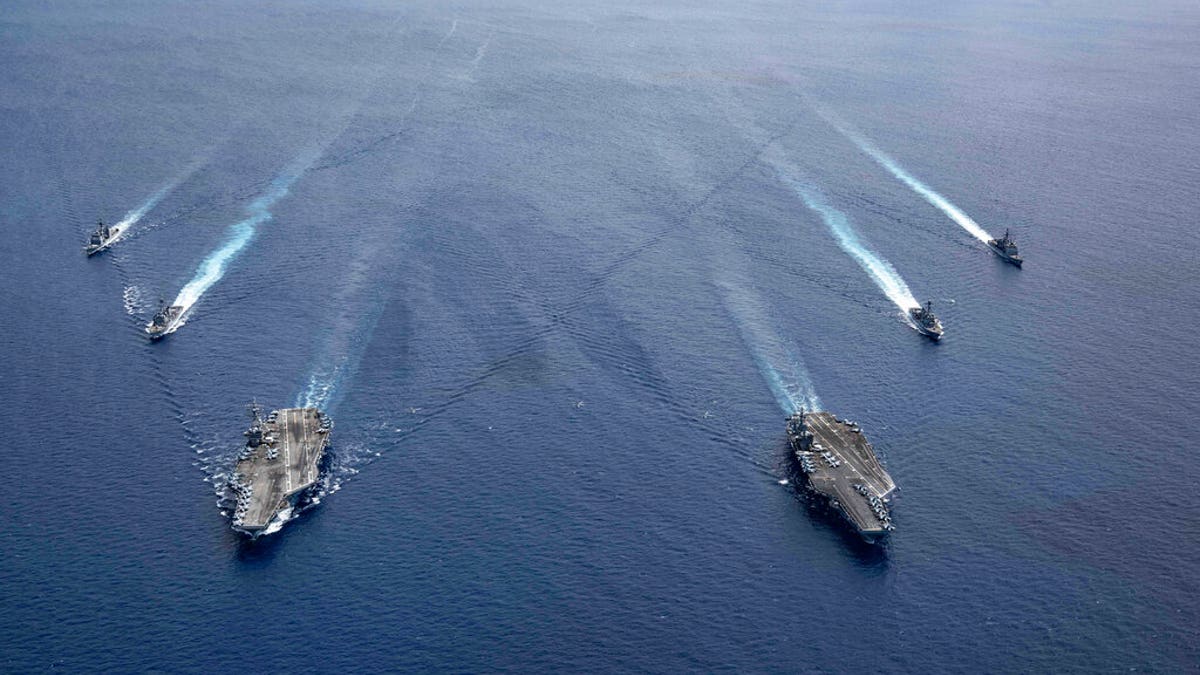Fox News Flash top headlines for July 15
Fox News Flash top headlines are here. Check out what's clicking on Foxnews.com.
A newspaper backed by the Chinese government is reporting that U.S. carriers in the South China Sea are “fully within the grasp of the Chinese People’s Liberation Army … which has a wide selection of anti-aircraft carrier weapons like the DF-21D and DF-26 ‘aircraft carrier missiles.’”
The Chinese report comes in response to U.S. dual-carrier training operations in the region using the USS Ronald Reagan and USS Nimitz. The U.S. drills involve decided efforts to prepare for the possibility of a coordinated, multicarrier attack. These types of operations succeed by virtue of elaborate networking and command and control and air-confliction efforts. They also deliver a massive advantage to maritime attack options by, essentially, doubling firepower, surveillance potential and weapons capability.
Not only would a dual-carrier attack option extend the Navy’s ability to hit inland targets to a larger extent, extend target-searching dwell time and enable coordinated multiplatform strikes, but they would also greatly improve destroyer-and-cruiser launched missile attacks. Each Carrier Strike Group consists of a carrier, cruiser and two destroyers, bringing a large, integrated combination of sea-launched assets.
NAVY ARMS SEA DRONES FOR OCEAN ATTACK
Also, perhaps of greater importance, the Chinese claim that U.S. carriers are extremely vulnerable is a question open to debate and varied interpretation.
The missiles are reported to have ranges as far as 900 nautical miles and have been considered a significant threat to U.S. carriers. At the same time, U.S. Navy leaders have been clear that U.S. carriers are able to operate where needed at any time. There is a range of factors to consider with this. First, the reported range of these kinds of Chinese carrier killer missiles does not present as serious of a threat to closer-in carriers unless it has precision-guidance systems and an ability to hit moving targets. Also, while much is naturally not discussed for understandable security reasons, the U.S. Navy continues to rapidly advance new technologies improving its layered ship defense systems.

The USS Ronald Reagan (CVN 76) and USS Nimitz (CVN 68) Carrier Strike Groups steam in formation, in the South China Sea, Monday, July 6, 2020. China on Monday, July 6, accused the U.S. of flexing its military muscles in the South China Sea by conducting joint exercises with two U.S. aircraft carrier groups in the strategic waterway. (Mass Communication Specialist 3rd Class Jason Tarleton/U.S. Navy via AP)
Carriers regularly travel in strike groups, meaning they are defended by destroyers, cruisers and various airborne surveillance and attack assets. Secondly, the Navy continues to make rapid strides arming its surface ships with new laser weapons and advanced EW [Electronic Warfare] systems likely to “jam” incoming missiles, stopping them, destroying their trajectory or simply throwing them off course.
Furthermore, the Navy’s layered defense system not only includes new longer-range aerial, space and ship-based sensors, but deck-fired interceptors that continue to receive software upgrades for improved accuracy. For instance, the Navy’s SM-6 missiles and Evolved Sea Sparrow Missile Block II are now engineered with software and sensor upgrades which enable them to better discern and destroy approaching “moving targets.” SM-6 technical upgrades, for example, engineer a “dual-mode” seeker into the weapon itself which enables it to better distinguish moving targets and adjust in flight to destroy them.
NAVY TESTS NEW SLEEK, STEALTHY DESTROYER HULL IN ROUGH SEAS
The ESSM Block II, also, has a sea-skimming mode that allows the interceptor to destroy approaching missiles flying parallel to the surface at lower altitudes. Some newer, advanced interceptors, by extension, no longer rely purely upon a ship-based illuminator but rather semi-autonomously receive electronic “pings” and make in-flight adjustments to destroy an approaching anti-ship missile.
New aerial sensors as well, such as advanced drones and the ISR (Intelligence Surveillance and Reconnaissance)-capable F-35C stealth fighter are likely to be successful in proving an “aerial node” surveillance asset able to help cue surface commanders of approaching missiles. They would also help ships attack and, in some instances, intercept or destroy an approaching anti-ship missile from the air. In fact, this very capability is already deployed by U.S. Navy destroyers; it is called Naval Integrated Fire Control-Counter Air. This is a system that uses an aerial node such as a Hawkeye surveillance plane or even F-35 to detect approaching threats from beyond the horizon, network with ship-based command and control, and enable a well-guided SM-6 interceptor missile to take out the approaching missile at long ranges.
CLICK HERE TO GET THE FOX NEWS APP
What all of this means is that, despite Chinese claims that its carrier killer missiles make carriers “obsolete,” it seems reasonable that aircraft carrier battle groups could successfully defend against them. This would be particularly true should carriers be flanked by well-armed DDG 51 destroyers. Perhaps these factors may be part of why U.S. Navy leaders continue to say its carriers can successfully operate wherever they need to. Finally, successful intercept of 900-nautical mile anti-ship missiles may prove to be less pressing with the arrival of the carrier-launched MQ-25 Stingray refueler which, at very least, promises to nearly double the attack range of deck-launched fighters such as the F-35C and F/A-18 Super Hornet.
Kris Osborn is the Managing Editor of Warrior Maven and The Defense Editor of The National Interest.





















